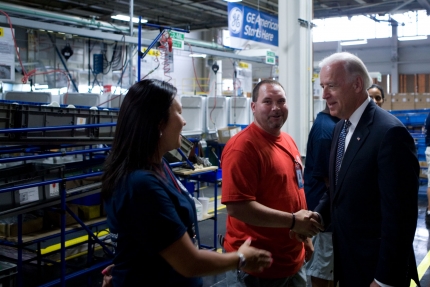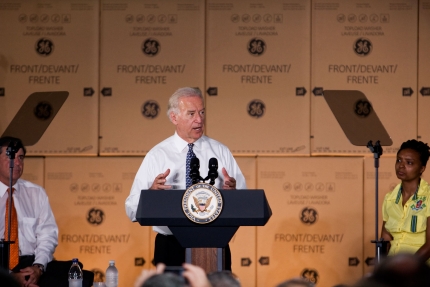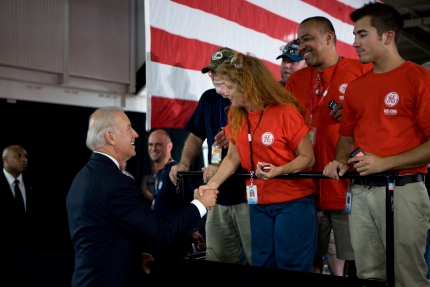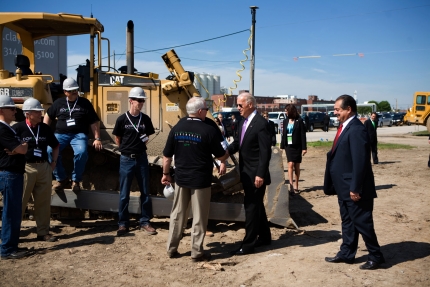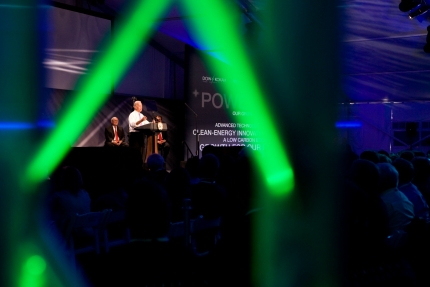The Recovery Act Blog
Weatherizing 82,000 Homes This Summer
Posted by on July 7, 2010 at 10:53 AM EDTPicture a neighborhood block somewhere in your town. It might have single-story homes for 10 families -- complete with front porches, sidewalks and green lawns. Or instead that block might have a single apartment building that houses 50 families over five floors. What we know is that each of the families -- whether they're living in a detached house or a mid-rise apartment -- pays away some of their hard-earned dollars to pay for energy. And for many low-income Americans, these energy bills absorb a significant amount of the family income.
Now imagine that teams of trained experts come down that block and install measures to help those families save energy. Insulation, caulking, weatherstripping, windows, better furnaces or water heaters. So families' energy bills go down and their comfort goes up. We call this 'weatherization' -- and it's happening in more than 82,000 homes as part of the Recovery Summer.
Learn more about Energy and EnvironmentPresident Obama on June Jobs Numbers: A Positive Six Months
Posted by on July 2, 2010 at 11:34 AM EDTIn a month where one might easily be confused by the official jobs numbers, the President followed up on CEA Chair Christina Romer’s excellent explanation this morning by laying down the bottom line:
This morning, we received the June employment report. It reflected the planned phase out of 225,000 temporary Census jobs. But it also showed the sixth straight month of job growth in the private sector. All told, our economy has created nearly 600,000 private sector jobs this year. That’s a stark turnaround from the first six months of last year, when we lost 3.7 million jobs at the height of the recession.
Now, make no mistake: We are headed in the right direction. But as I was reminded on a trip to Racine, Wisconsin, earlier this week, we’re not headed there fast enough for a lot of Americans. We’re not headed there fast enough for me, either. The recession dug us a hole of about 8 million jobs deep. And we continue to fight headwinds from volatile global markets. So we still have a great deal of work to do to repair the economy and get the American people back to work.
Speaking at Andrews Airforce Base on his way to Charleston, West Virginia for the Senator Byrd’s memorial service, the President also emphasized another key point: the Recovery Act is still in action, and still putting people back to work. The President took the opportunity to announce yet another component of the “Summer of Recovery”:
Learn more about EconomyError-Filled Republican Analysis Misleads On Recovery Act
Posted by on June 30, 2010 at 5:28 PM EDTToday Rep. Boehner released an error-filled paper on the Recovery Act that is full of half-truths and mistakes.
Leading independent economists, the nation’s governors and the millions of Americans on the job thanks to the Recovery Act all say it’s helped rescue the economy, so it’s ironic that the very critics who refuse to acknowledge it’s working are those whose economic policies led us into this crisis in the first place. Republicans in Congress may have made a cynical bet to deem the Recovery Act a failure before it even began, but even they can’t ignore the facts: after years of failed policies, the Recovery Act has helped us go from losing over three million private sector jobs in the first five months of last year to adding 495,000 in the first five months of this year, and from an economy shrinking by six percent to an economy growing three percent.
Among the biggest errors in Representative Boehner’s report are:
“[T]he ‘stimulus’ isn’t working as promised.”
- In fact, the nonpartisan Congressional Budget Office says the Recovery Act is already responsible for as many as 2.8 million jobs and on track for about 3.5 million by the end of the year – exactly the projected target at the time the Recovery Act was signed. [CBO Report, May 2010]
Learn more about EconomyBringing Green Manufacturing Back Home
Posted by on June 29, 2010 at 5:55 PM EDTWe talk a lot about the need for America to lead the world in green manufacturing, and with good reason: a strong green manufacturing sector will create good, domestic jobs and boost exports, all while helping us reduce carbon emissions and break our dependence on foreign oil.
But it’s not just talk. We’re taking action to re-establish that leadership, and what’s happening today, down in Louisville, Kentucky, is a perfect example of how we’re going to do it.
Vice President Biden was in Louisville today to visit a General Electric facility called Appliance Park, where GE is investing $600 million to expand their manufacturing of energy-efficient appliances. But they’re not doing it alone – their investment is being supported by $24.8 million in Recovery Act funds through a program called the Section 48C Advanced Energy Manufacturing Tax Credit, or “48C” for short.
Learn more about EconomyGE and the Recovery Act
Posted by on June 29, 2010 at 2:50 PM EDTYesterday Vice President Biden travelled to Louisville, Kentucky where he visited the headquarters of GE Appliances to discuss how Recovery Act investments are creating jobs and laying a new foundation for long-term economic growth in the state.
Appliance Park is a huge industrial campus, covering more than 900 acres, employing 3,600 people, and producing approximately 3 million units a year. You can tell that people in the community take pride in the company and the products that it makes.
We saw it firsthand when we walked into Building 3, where they manufacture energy efficient dishwashers. The manufacturing floor was still hot from recent production and enthusiastic GE employees in their matching red and blue shirts filled the room to welcome Vice President Biden and share the good news about how business is doing. People were excited and undeniably optimistic.
It’s hard to imagine that in 2008 GE Appliances was up for sale and facing a financial crisis. For many workers, the future was uncertain. And yet, less than two years later, GE has experienced a dramatic turnaround thanks to their innovative spirit, local, state, and federal support, and a strengthened partnership with the union.
GE is now investing $600 million to expand manufacturing production at Appliance Park. The investment is supported by $24.8 million in 48C Advanced Energy Manufacturing Tax Credits that GE received under the Recovery Act to retrofit and re-tool the Appliance Park facility for the manufacturing of three energy-efficient product lines: dishwashers, clothes dryers, water heaters. With the addition of the three new product lines, they plan to add over 800 new jobs through 2013.
And these product lines are state-of-art: the water heater uses 62 percent less energy than conventional water heaters and saves the average family $320 a year. It’s also the first new product line manufactured at Appliance Park in 50 years.
The Recovery Act also included consumer incentives for energy efficient appliances, and these rebates have boosted sales of high efficiency appliances. Sales of the dishwashers being built in Building 3 have increased by 20 percent as a result of the Recovery Act consumer rebates. And sales of the clothes washers manufactured in Building 1 are up more than 100 percent. GE even had to add a second shift and hire 137 new employees to handle the increased demand.
Learn more about EconomyGroundbreaking Another Example of Recovery Act at Work
Posted by on June 22, 2010 at 9:28 AM EDTYesterday, Vice President Biden and the Energy Department’s Assistant Secretary Cathy Zoi were in Midland, MI, to celebrate the groundbreaking of Dow Kokam's 800,000 square foot battery manufacturing factory. This is part of the Summer of Recovery, demonstrating successful Recovery Act projects that are putting Americans back to work in the short term and investing in a clean energy economy. Dow Kokam estimates its project has already created or preserved approximately 100 construction jobs – this will rise to 1,000 jobs at the peak of construction. The bulk of the estimated 800 full time jobs will come in the second half of 2011, when Dow will begin hiring and training permanent employees.
The Dow plant is part of the Recovery Act’s $2 billion investments in advanced battery manufacturing, supporting 20 battery and 10 component manufacturing factories. These include several other Michigan factories including A123, Compact Power, GM, and Johnson Controls. At full scale, the Obama Administration’s investments will support factories with the capacity to supply more than 500,000 plug-in hybrid and electric drive vehicles. Dow will build enough batteries to supply 60,000 electric-drive vehicles, scaling up a proven process to build lithium-ion batteries.
These factories, supported by the Recovery Act, are helping build an important domestic industry – the US produced less than 2 percent of the world’s batteries for advanced vehicles in 2008. By the end of 2012, the US is estimated to have the capacity to produce 20 percent of the world’s lithium-ion batteries for vehicles. By 2015, this could be even higher.
The Recovery Act's battery factories are scaling up production, and also lowering costs. By 2013, these factories will help cut battery costs in half – making electric drive vehicles much more affordable for Americans. Additional Administration investments in cutting edge research projects, led by the Energy Department, will continue this type of innovation well beyond 2015, providing a long-term path for a competitive industry.
Matt Rogers is Senior Advisor to Secretary of Energy Steven Chu for Recovery Act Implementation
- &lsaquo previous
- 1
- 2
- 3
- 4
- 5
- 6
- 7
- 8
- 9
- …
- next &rsaquo
White House Blogs
- The White House Blog
- Middle Class Task Force
- Council of Economic Advisers
- Council on Environmental Quality
- Council on Women and Girls
- Office of Intergovernmental Affairs
- Office of Management and Budget
- Office of Public Engagement
- Office of Science & Tech Policy
- Office of Urban Affairs
- Open Government
- Faith and Neighborhood Partnerships
- Social Innovation and Civic Participation
- US Trade Representative
- Office National Drug Control Policy
categories
- AIDS Policy
- Alaska
- Blueprint for an America Built to Last
- Budget
- Civil Rights
- Defense
- Disabilities
- Economy
- Education
- Energy and Environment
- Equal Pay
- Ethics
- Faith Based
- Fiscal Responsibility
- Foreign Policy
- Grab Bag
- Health Care
- Homeland Security
- Immigration
- Innovation Fellows
- Inside the White House
- Middle Class Security
- Open Government
- Poverty
- Rural
- Seniors and Social Security
- Service
- Social Innovation
- State of the Union
- Taxes
- Technology
- Urban Policy
- Veterans
- Violence Prevention
- White House Internships
- Women
- Working Families
- Additional Issues

